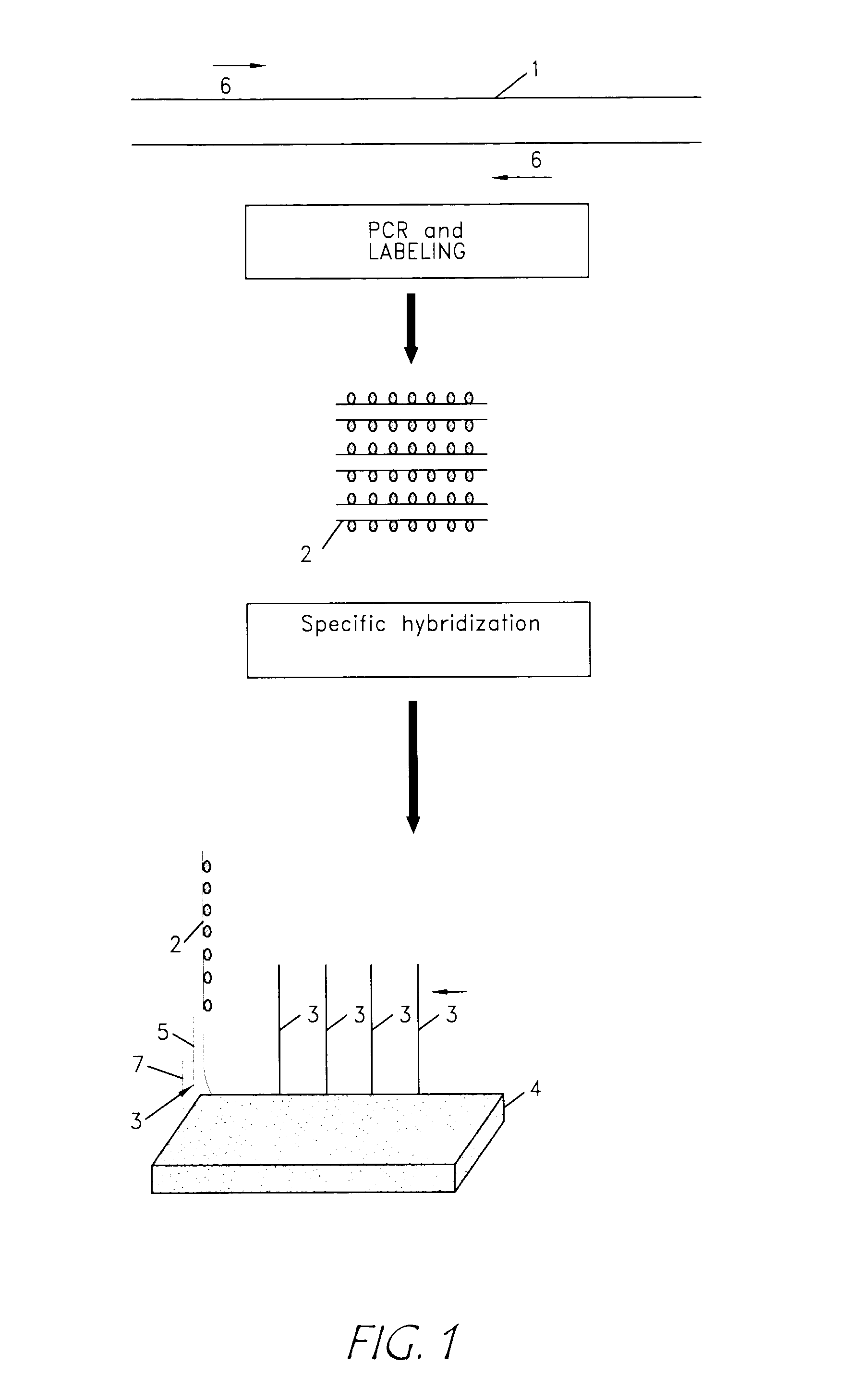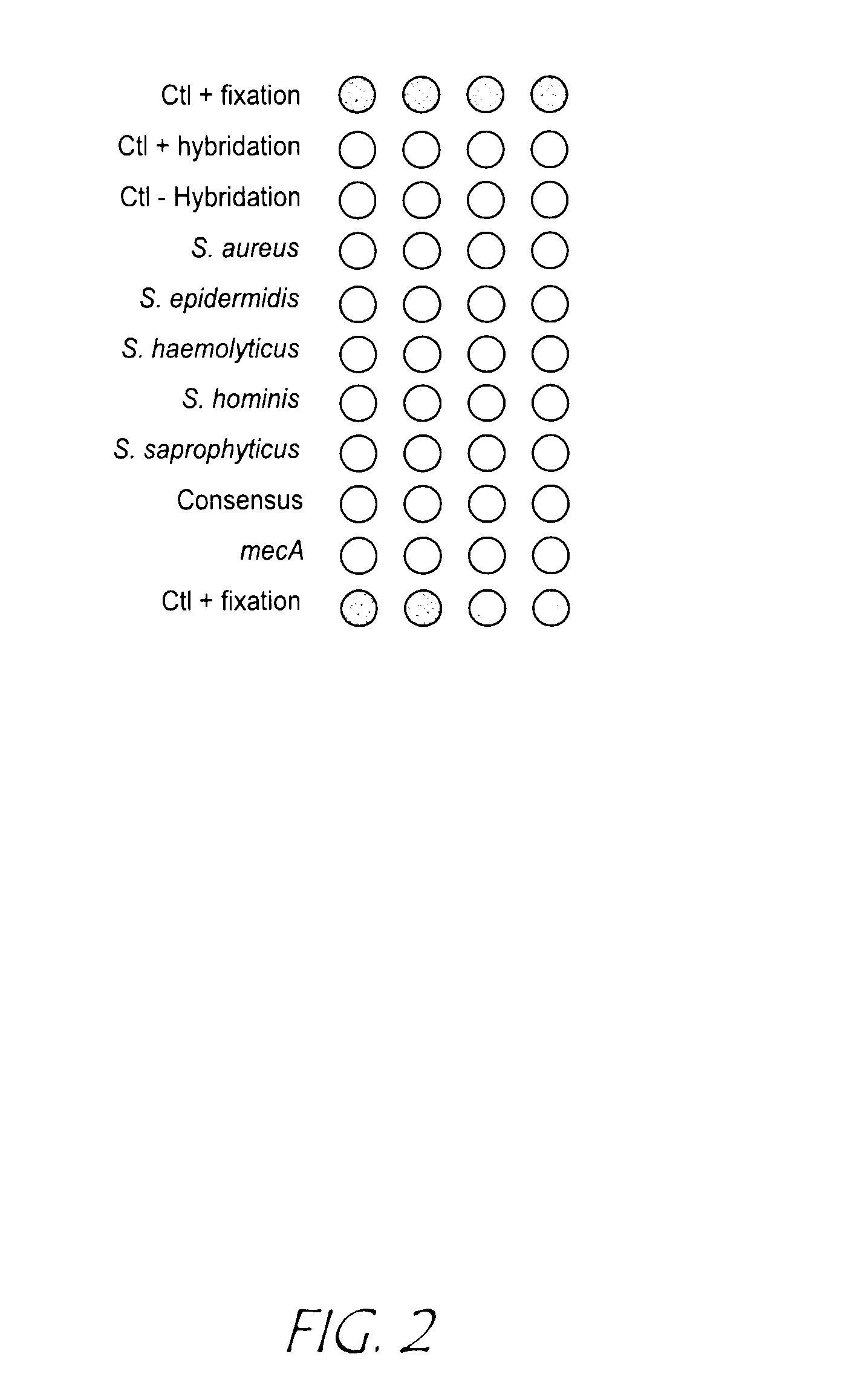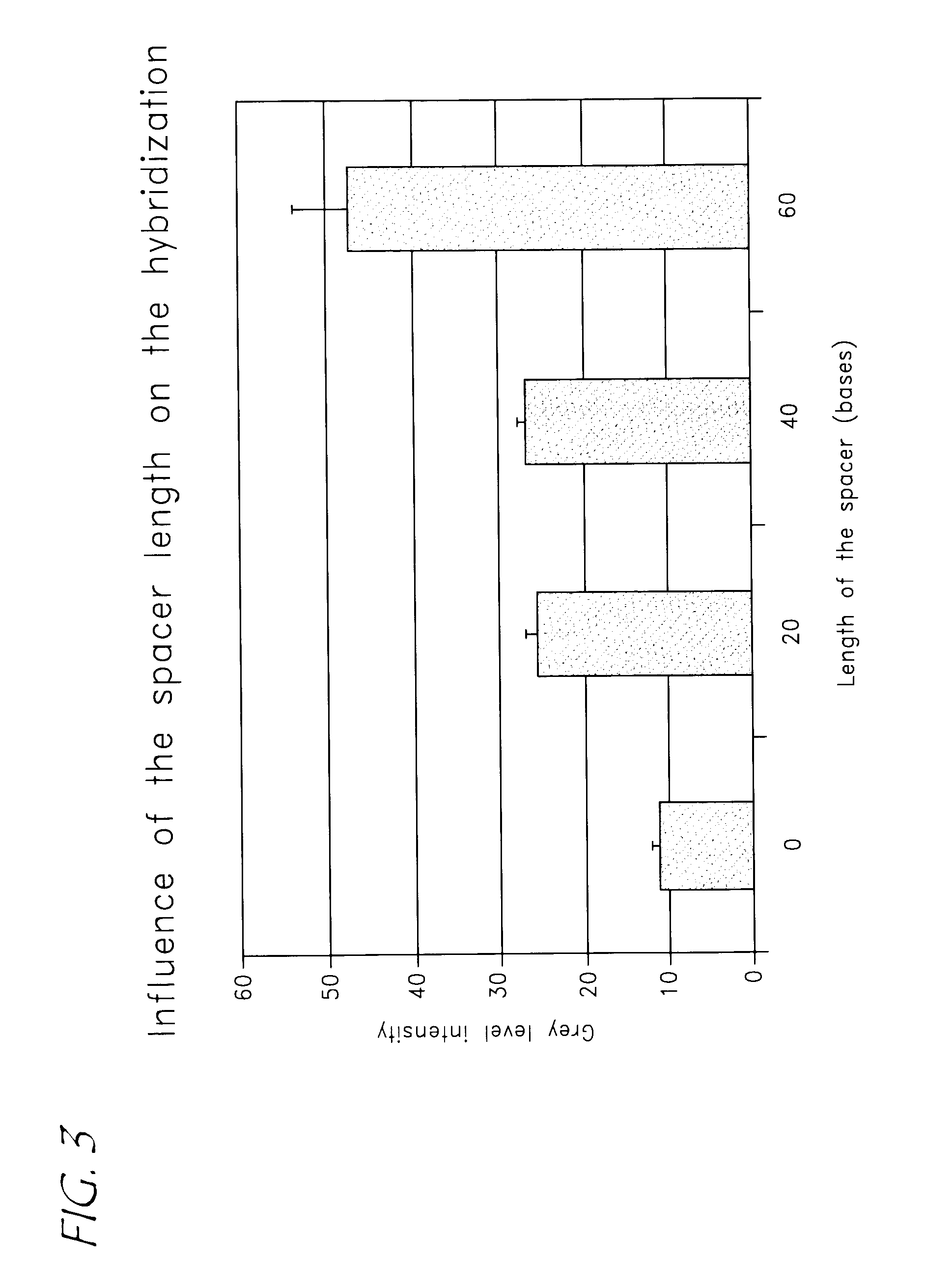Identification of biological (micro) organisms by detection of their homologous nucleotide sequences on arrays
a technology of nucleotide sequence and array, applied in the field of diagnosis, can solve the problems of long dna or rna fragment hybridization, lack of method sensitivity, and inability to detect directly amplicons, and achieve the effect of easy identification (detection and/or quantification)
- Summary
- Abstract
- Description
- Claims
- Application Information
AI Technical Summary
Benefits of technology
Problems solved by technology
Method used
Image
Examples
example 1
Detection of Homologous FemA Sequences on Array Bearing Long Specific Capture Nucleotide Sequences
Production of the Capture Nucleotide Sequences and of the Targets
[0079]The FemA genes corresponding to the different Staphylococci species were amplified separately by PCR using the following primers:
[0080]
(SEQ ID NO: 1)S. aureus 1:5′ CTTTTGCTGATCGTGATGACAAA 3′(SEQ ID NO: 2)S. aureus 2:5′ TTTATTTAAAATATCACGCTCTTCG 3′(SEQ ID NO: 3)S. epidermidis 1:5′ TCGCGGTCCAGTAATAGATTATA 3′(SEQ ID NO: 4)S. epidermidis 2:5′ TGCATTTCCAGTTATTTCTCCC 3′(SEQ ID NO: 5)S. haemolyticus 1:5′ ATTGATCATGGTATTGATAGATAC 3′(SEQ ID NO: 6)S. haemolyticus 2:5′ TTTAATCTTTTTGAGTGTCTTATAC 3′(SEQ ID NO: 7)S. saprophyticus 1:5′ TAAAATGAAACAACTCGGTTATAAG 3′(SEQ ID NO: 8)S. saprophyticus 2:5′ AAACTATCCATACCATTAAGTACG 3′(SEQ ID NO: 9)S. hominis 1:5′ CGACCAGATAACAAAAAAGCACAA 3′(SEQ ID NO: 10)S. hominis 2:5′ GTAATTCGTTACCATGTTCTAA 3′
[0081]The PCR was performed in a final volume of 50 μl containing: 1.5 mM MgCl2, 10 mM Tris pH 8....
example 2
Detection of Homologous FemA Sequences on Array Bearing Small Specific Capture Nucleotide Sequences
[0088]Protocols for capture nucleotide sequences immobilisation and silver staining detection were described in example 1 but the capture nucleotide sequences specific of the 5 Staphylococcus species were spotted at concentrations of 600 nM and are the following:
[0089]
NameCapturenucleotidesequenceSequence (5′ -> 3′)ATaur02ATTTAAAATATCACGCTCTTCGTTTAG(SEQ ID NO: 11)ATepi02ATTAAGCACATTTCTTTCATTATTTAG(SEQ ID NO: 12)Athae02ATTTAAAGTTTCACGTTCATTTTGTAA(SEQ ID NO: 13)AThom02ATTTAATGTCTGACGTTCTGCATGAAG(SEQ ID NO: 14)ATsap02ACTTAATACTTCGCGTTCAGCCTTTAA(SEQ ID NO: 15)
[0090]In this case, the targets are fragments of the FemA gene sequence corresponding to the different Staphylococci species which were amplified by a PCR using the following consensus primers:
[0091]
(SEQ ID NO: 16)APstap03:5′ CCCACTCGCTTATATAGAATTTGA 3′(SEQ ID NO: 17)APstap04:5′ CCACTAGCGTACATCAATTTTGA 3′(SEQ ID NO: 18)APstap05:5′ GGT...
example 3
Effect of the Spacer Length on the Sensitivity of Detection of Homologous FemA Sequences on Array Bearing Long Capture Nucleotide Sequences with a Small Specific Sequence
[0094]The experiment was conducted as described in example 2 with the same amplicons but the capture nucleotide sequences used are the following:
[0095]
NameCapturenucleotidesequenceSequence (5′ -> 3′)Ataur02ATTTAAAATATCACGCTCTTCGTTTAG (SEQ ID NO: 11)ATepi02ATTAAGCACATTTCTTTCATTATTTAG (SEQ ID NO: 12)Atepi03GAATTCAAAGTTGCTGAGAAATTAAGCACATTTCTTTCATTATTTAG(SEQ ID NO: 19)ATepi04GAATTCAAAGTTGCTGAGAATAGTTCAATGGAAGGAAGCGATTAAGCACATTTCTTTCATTATTTAG (SEQ ID NO: 20)ATepi05GAATTCAAAGTTGCTGAGAATAGTTCAATGGAAGGAAGCGTCTTCTTAAAATCTAAAGAAATTAAGCACATTTCTTTCATTATTTAG (SEQ ID NO: 21)aThe spacer sequences are underlined
[0096]The target amplicons were 489 bp long while the capture nucleotide sequences were 47, 67 or 87 bases single-stranded DNA with a specific sequence of 27 bases (FIG. 3).
PUM
| Property | Measurement | Unit |
|---|---|---|
| distance | aaaaa | aaaaa |
| volume | aaaaa | aaaaa |
| diameter | aaaaa | aaaaa |
Abstract
Description
Claims
Application Information
 Login to View More
Login to View More - R&D
- Intellectual Property
- Life Sciences
- Materials
- Tech Scout
- Unparalleled Data Quality
- Higher Quality Content
- 60% Fewer Hallucinations
Browse by: Latest US Patents, China's latest patents, Technical Efficacy Thesaurus, Application Domain, Technology Topic, Popular Technical Reports.
© 2025 PatSnap. All rights reserved.Legal|Privacy policy|Modern Slavery Act Transparency Statement|Sitemap|About US| Contact US: help@patsnap.com



